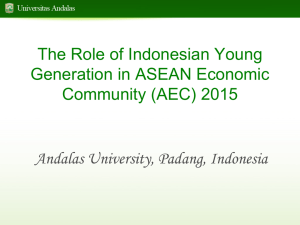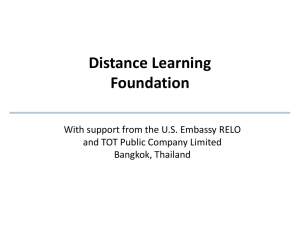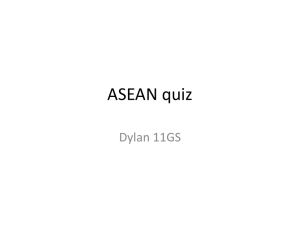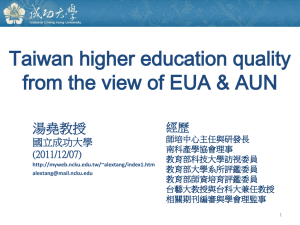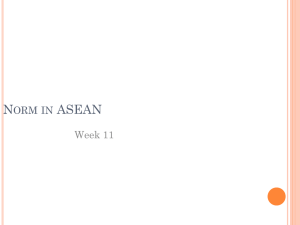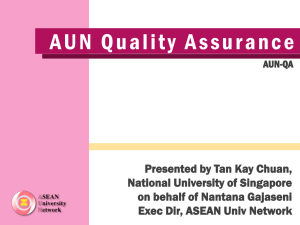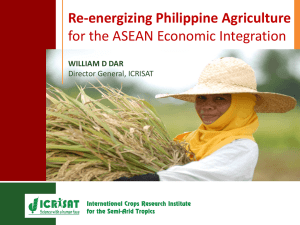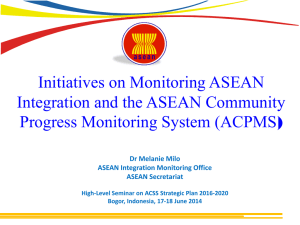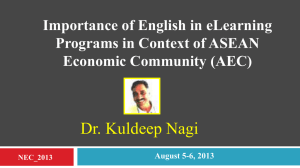Presentation
advertisement
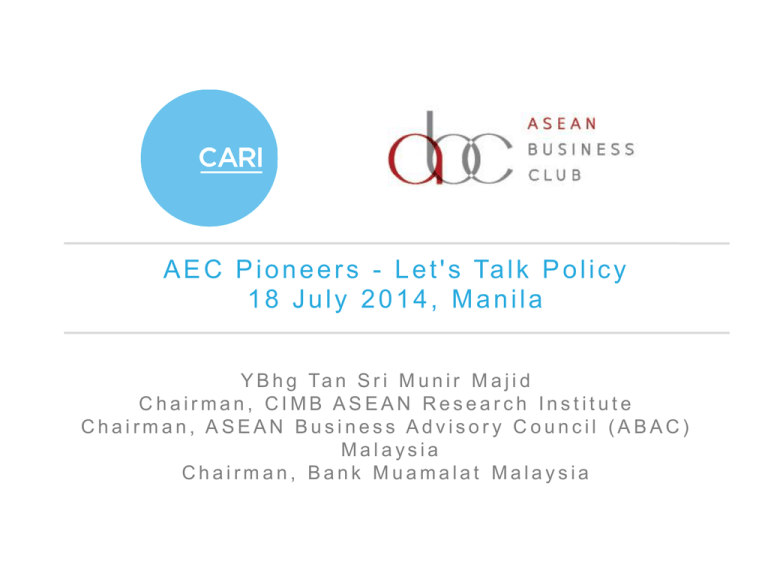
A E C P i o n e e r s - L e t ' s Ta l k P o l i c y 18 July 2014, Manila Y B h g Ta n S r i M u n i r M a j i d Chairman, CIMB ASEAN Research Institute Chairman, ASEAN Business Advisory Council (ABAC) Malaysia Chairman, Bank Muamalat Malaysia THE ASEAN ECONOMIC COMMUNITY (AEC) MECHANISM AEC Blueprint Where are we going? AEC Roadmap How do we get there? AEC Scorecard How are we progressing? THE ASEAN ECONOMIC COMMUNITY (AEC) MECHANISM AEC Blueprint Where are we going? Single market and production base Competitive Economic Region Equitable Economic Development Integration into the Global Economy THE ASEAN ECONOMIC COMMUNITY (AEC) MECHANISM AEC Scorecard How are we progressing? 2012 Scorecard (latest publication) Single market and production base Competitive Economic Region Equitable Economic Development Integration into the Global Economy THE ASEAN ECONOMIC COMMUNITY (AEC) MECHANISM AEC Scorecard How are we progressing? Single market and production base Updated: Competitive Economic Region Equitable Economic Development Integration into the Global Economy =79.7% as of the 23rd ASEAN summit in October 2013 KEY SECTORS STILL FACE POLICY BARRIERS Policy Barriers: 1. Non-acceptance of ASEAN agreements and protocols 2. Non-inclusion of seventh freedom and domestic operations 3. Ownership and control restrictions 4. Competitive threat from Non-ASEAN carriers 1. OTC market development 2. Broadening investor base 3. Enhancing liquidity 4. Furthering integration 1. Fiscal constraints 2. Lack of investor-ready PPP project pipeline 3. Complex execution due to regulatory and institutional inefficiencies 4. Ineffective governance systems KEY SECTORS STILL FACE POLICY BARRIERS Barriers identified by the LTBs: 1. Heterogeneity of regulatory framework and restrictive market access 2. Constraints on Talent Mobility 3. Cross border data flow and off shoring regulatory constraints 4. PAN Asia trade flow and focus on China and India 5. Lack of Standard Infrastructure to facilitate cross border credit 6. Lack of Standardisation across the region with respect to operational process and common infrastructure 1. Roaming and International Direct Dialling Costs 2. Capitalising on Mobile Advertising 3. Capitalising on Mobile Payments 1. Economic Gap 2. Barriers in Human Capital 3. Infrastructural Barriers 4. Cultural and Policy Gaps R E S E A R C H S H O W S L I B E R A L I S AT I O N I N T H E A S E A N AV I AT I O N I N D U S T RY W O U L D Y I E L D S I G N I F I C A N T B E N E F I T S • Numerous comprehensive studies on the benefits of air services liberalisation for ASEAN countries have been made, of which most are unanimous that the overall benefits of liberalising the aviation industry include: Increased choice More competition Lower fares Lower freight rates Indonesia Increased tourism Increased foreign investment revenue Growth in related services Increased employment in airline-related jobs Malaysia and Thailand • Research objective: Quantify benefits for Indonesia in 2025 of an ‘ASEAN Open Skies’ policy • Estimated size of benefits: Additional GDP = 7 trillion Rupiah (US$679 million) Additional jobs created = 32,000 Decrease in real air fares = 2.5% per annum Additional international passenger traffic = 16.3 million per year by 2025 Additional international air freight traffic = 290,000 tonnes per year by 2025 • Research objective: Study the impact of liberalisation (unlimited 3rd and 4th freedom rights)between the two countries in 2005. • Size of benefits: No. of passengers travelling between the two countries = 1.5 million No. of passengers travelling as a result of the liberalised arrangement = 370,000 Additional full-time jobs (per country) = 4,300 (est.) Additional GDP (per country) = US$114 million Source: InterVISTAS-ga (2006) Source: Indonesia Infrastructure Initiative (IndII) (2011) 8 CASE STUDY: MYANMAR Infrastructure need of large cities in Myanmar • In 2011, Myanmar spent only US$800 million on infrastructure. However, the country has the potential to quadruple the size of its economy, from US$45 billion in 2010 to over US$200 billion in 2030 but in order to support the targeted 8% GDP growth, Myanmar needs to increase its infrastructure stock. • Myanmar is estimated to need a total infrastructure and real estate investment of US$320 billion between 20102030, according to McKinsey Global Institute report on Myanmar. • About 60% of this investment needs to be in residential and commercial real estate, but power plants, water infrastructure, road and rail networks also require substantial investment. Source: McKinsey Global Institute CityScope Database 2.0; Pike Research; Japan International Corporation Agency; McKinsey Infrastructure Practice benchmarks per asset type; McKinsey Global Institute analysis Large cities in Myanmar would likely need to invest US$147 billion from 2010-2030 to upgrade infrastructure for existing population and new arrivals. • With increasing urbanisation, large cities alone will need about 45% of the estimated infrastructure need. • There are several megaprojects being planned by the government, including: Dawei special economic zone Sittwe port on the Indian Ocean Kyaukpyu Industrial Zone 9 CASE STUDY: INDONESIA • Indonesia’s infrastructure challenge is the key impediment to reaching a potential GDP growth rate of 8%, according to McKinsey Global Institute. Infrastructure spending 2004 - 2009 Indonesia’s infrastructure spending excluding transport is far below 2% of GDP. • The government has acknowledged that Indonesia needs around US$30 billion annually (4 % of GDP) in infrastructure investment for the next 5 years. • The capacity of the road network on the island of Java, home to about 60% of the population, would need to be tripled but has seen limited expansion in the last decade. • Law and regulation changes as well as new initiatives are being instituted to enable faster infrastructure development, including the “fast-track” electricity development programmes (2006) private sector participation in electricity (2009) the land acquisition law (2012) • Infrastructure spending in nominal terms has been on the rise but it has consistently stayed well below 2% of GDP. • Government initiatives have thus far been insufficient in catalysing the infrastructure development that the country needs. Source: McKinsey Global Institute analysis, : Indonesia’s Ministry of National Development Planning 10 W E L FA R E G A I N S F O R ASEAN COUNTRIES IF THESE BARRIERS ARE NOT OVERCOME, ASEAN WILL NOT REAP THE POTENTIAL BENEFITS OF AEC • Research shows that the potential average income gain from full implementation of the AEC are about 5% • These benefits should grow over time as the region's economies mature and evolve to make economic integration more productive • The potential welfare benefits are even greater when ASEAN engages in external partnerships (8.9% for AEC+ and 11,6% for AEC++) • These benefits will not be realised in 2015 if ASEAN does not reach full implementation AEC = Full implementation of the AEC AEC+ = 1.+ FTAs with Australia, New Zealand, India, Japan, China, S-Korea AEC++ = 1.+ 2.+ FTAs with USA and the EU Source: Petri, Plummer, Zhai, 2012, Economic Community: A General Equilibrium Analysis POTENTIAL INCREASE IN ASEAN EXPORTS • According to research, exports from ASEAN have the potential of increasing by more than 40% with full implementation of the AEC, and up to 89% with FTAs with external partners • The potential increase of ASEAN exports will likewise only be realised if the AEC is fully implemented and succeeds in building external partnership AEC = Full implementation of the AEC AEC+ = 1.+ FTAs with Australia, New Zealand, India, Japan, China, S-Korea AEC++ = 1.+ 2.+ FTAs with USA and the EU Source: Petri, Plummer, Zhai, 2012, Economic Community: A General Equilibrium Analysis 39% BUSINESSES HAVE NO OR LIMITED KNOWLEDGE ON THE AEC • The 2013 ABAC survey on ASEAN Competitiveness found that 39% of respondent businesses have no or limited knowledge on ASEAN policy initiatives Knowledge of ASEAN policy initiatives No knowledge = 7% Limited knowledge = 32% = 39% Source: M.H. Wong & A. Wirjo, 2013 YET, 75%OF ASEAN SMES THINK THE AEC WILL POSITIVELY IMPACT THEIR BUSINESS A study of SME agencies in each AMS and 93 ASEAN SME entrepreneurs: Source: The ASEAN SME Regional Development Fund Conceptual Framework. A B O U T 7 0 % F I R M S A R E N O T U S I N G A S E A N F TA S • A 2012 ABAC survey on ASEAN competitiveness found that only 29% of respondents revealed that their organisations used preferential provisions in ASEAN or ASEANplus economic agreements. Use of preferential provisions in ASEAN agreements among firms: 46% of firms do not plan to use preferential provisions ASEAN NEEDS TO IMPROVE ITS COMMUNICATION Private Sector o corporations o business leaders o industry players ASEAN MESSAGING Public sector o civil societies o civil servants o politicians General public o school Children o youth THINK ASEAN
